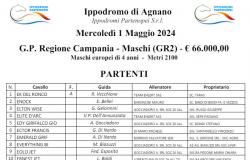ALEXANDRIA – There was talk of Pfas during the last joint meeting of the Culture, Security and Environment Commissions of Alexandria, dedicated to the presentation of the new Research and Development Center for Environmental Reclamation and Protectiona project funded by Solvay (Today Syensqoed.) with 5 million euros intended forUniversity of Eastern Piedmont. At the end of the professor’s report Leonardo Marchesethe scientific director of the center, the president of the Safety and Environment Commission, Adriano Di Saverioasked the director of the Solvay plant in Spinetta Stefano Colosio if in this project “There were also prospects for reducing the environmental impact of the PFAS emitted and polluting air and water. Arpa’s latest data on air control units are not particularly comforting”.
“PFOA was invented in 1960, it was produced by 3M, DuPont, Chemours and Miteni” underlined the director Stefano Colosio (photo below) “Solvay purchased it to use it as a polymerization aid, it is soluble in water so it currently pollutes the groundwater. Since 2013, seven years before its ban, it has no longer been used by Solvay. Operational safety measures that collect water from the aquifer and purify it are still a means of purifying the land. It is clear that it will take some time but for the moment it is the only technology we have available. At the same time also the new Pfas (the Adv and the C6o4) they are progressively eliminated from the ground with the same methodology. C604 is still in use but with the prospect of abandoning it 99% at the end of 2026. Abandoning a polymerization aid is not something trivial. It would be like asking a chef to fry food without oil. It’s possible, there are air fryers but it’s not easy to do. It will take us some time but we are absolutely committed to eliminating this adjuvant as long as new technologies allow us to do so. In fact, the search does not yet give us the possibility of eliminating other products. We need the University because not for all the pollutants in the Spinetta subsoil there is an obvious, clear and practical technology to achieve a complete remediation of the land: the hydraulic barrier has a positive but not yet decisive effect on subsoil pollution. If it were possible to develop technologies to speed up this reclamation we would be happy: it is preferable to be on reclaimed land rather than have an economic activity on land suspected, in some it was not just a suspicion, of producing negative effects for the communities around us. Investing these 5 million is necessary to reach the conclusion of this journey which will take many years to execute.”
“Since 2005” added director Colosio “is in force in Europe the Reach regulation which brought order to the marketing of chemical products already on the market. Every company that invents a new molecule must ask for authorization from Echa (the European Chemicals Agency, ed.) before putting it on the market. Echa, depending on the circumstances, imposes an exhaustive research protocol to verify that this product is appropriately classified, depending on its toxicity and danger. The extent of this research depends on the quantity of substance you want to market. Studies have been carried out on c6o4, available to public bodies, and has not been classified as a particularly harmful chemical. C6O4 is significantly less harmful than its predecessor: PFOA. In some ways, therefore, We are surprised by this public aversion to a chemical substance that does not have many of the characteristics that its predecessors had. All Pfas have the common characteristic of not being biodegradable: in itself this is not very strange given that heavy metals and hydrocarbons are also not biodegradable but we commonly use them, for example to fill up with petrol. What can be worrying about PFOA is another of its characteristics: it is bioaccumulative. In the biomonitoring of our employees who used PFOA until 2013 we have observed that its concentration in the blood takes 4 years to halve. We fully agree with the Echa resolution that banned it. The concentration of C6o4 in the blood, however, halves in three days: the c6o4 is a radically less worrying product. We decided to dispose of it because public opinion is against it, not because it represents a real threat from an environmental point of view. We think, however, that the decommissioning of most productions by 2026 will be of comfort to everyone. The goal is also to have a possibly closed cycle treatment of the water coming from that last processing of substances that are particularly difficult to produce without c604, for which research is still working to find solutions. Eliminating the use of these chemical substances at the source is the most concrete response to limiting their environmental impact.”
“Talking about cleaning up the plant” continued Solvay director Colosio “for us the most important thing is to take into account the major contamination that occurred between 1930 and 1970, that of hexavalent chromium, a clearly carcinogenic substance that spreads easily in ground water. Although we have no legal obligations (the only obligation is operational safety) we have decided to undertake this cleanup to ensure that the local community can be relieved of a major environmental problem, with repercussions for generations to come. By operational safety we mean the hydraulic barrier: we still have the obligation to prevent past pollutants from spreading into the aquifer and therefore into the territory. Because of this we are spending around 4 million euros a year, in addition to the initial investment for the countless wells for water extraction. When it comes to reclamation many think that it is something decoded, in reality this is not true: Pollution cleanup is still a topic that needs research and development, these are not consolidated technologies. The current reclamation of chromium 6 in operation occurs thanks to research developments coming fromEastern Piedmont Universitywith the sodium dithionite which we use widely with great results. We have reclaimed 60% of the chromium in the area. Faced with such important problems, given that the technological knowledge resources are not sufficient, it seemed necessary to us to give an intellectual contribution to an institution like the Piedmont University which has already distinguished itself for being able to develop procedures that can be implemented practice, so that the territory and the establishment can benefit from it. We have made 5 million euros available for this research initiative, with the value of producing technology and qualified people who can be employed in the practice of these operations that last decades. We have been reclaiming for over 10 years and the prospect is not to finish anytime soon. To carry out chromium 6 remediation, in particular, Solvay needs special authorization to carry out a series of annual cycles. A detailed intervention plan is proposed to Arpa. Every year I propose a discussion with you to take stock of the reclamation, together with Arpa”.
“PFOA has been declared definitely carcinogenic by the International Agency for Research on Cancer” the observations of the president of the Safety and Environment Commission Adriano Di Saverio “it has been decommissioned since 2013 but unfortunately the latest analyzes carried out by the Region on foods such as eggs, milk and vegetables in areas surrounding the chemical hub were found in high quantities. How come? It’s true that a step forward has now been made with c6o4 given that it is a more easily metabolised substance but there is a lot of research at a medical and environmental level also on this type of pfas which testifies to alterations in the immune and endocrine system in the laboratory animals tested with c6o4. The problem is quite complex and complex“.
“This classification of PFOA as a carcinogenic substance has not been accepted by ECHA: evidently there are still doubts” replied the director of Solvay Stefano Colosio “as well as other studies on c6o4 have not yet produced any changes in the labeling and classification of this pfas. There may be many varied studies with different interpretations but in the end they must converge in a binding rule that everyone can use in the same way. Regarding the ubiquity of PFOA, I would like to thank the PresaDiretta program very much for the reportage: it has been demonstrated that many companies use PFOA. The Fire Brigade uses it as a foaming agent, it is a substance contained in paper for food packaging, in tanneries and in agriculture. The fact of finding it in food matrices is the result of this ubiquity.”
To know more:




